Intercommunity Interaction and preservation of Tribal Culture
Abstract
Intercommunity interactions provide the required momentum for a society to preserve peace and harmony, and to make progress. Observed intercommunity interactions in the tribal dominated heartland of Koraput district are studied, based on the basic livelihood issues. The study is based on a strong theoretical assumption followed by critical analysis of the field data. The study, while exploring the indigenous socio-cultural environment and its role in intercommunity interaction and preservation of tribal culture, clarifies some of the age-old doubts on untouchability and the social hierarchy among the tribal and the non-tribal population, and reveals the cultural integration featured in intercommunity interaction.
Key words: Intercommunity interactions, tribal culture, socio-religious functions, livelihood issues
Introduction
Social networking is one of the essential needs of the society to preserve peace and harmony, and to make progress in the society. This is achieved either through communication and social interaction between individual members or through intra and inter community interactions. Communication and social interactions between individuals or within the community are classified as observable and unobservable interactions( phone calls, charts, emails etc.). Observed social interactions are prevalent in a wide array of social settings in the form of rituals, inter-dinning during feasts, marriages across the communities (beyond prescriptions), and conflict resolutions.
In India, heterogeneity is woven into the fabric of each and every community and culture. These diverse cultures and communities have been coexisting through ages on the basis of principles of harmony and tolerance. But no doubt conflicting situations and contradictions arise and also get resolved from time to time, realizing the necessity of coexistence and cultural identity. Intercommunity interaction helps in resolving conflicts. Intercommunity interaction is facilitated in north-eastern India through a community software solution framework (CSSF), operated through the joint effort of National Informatic Centre (NIC) and United Nation Educational, Scientific and Cultural Organisation (UNESCO), New Delhi. This software is quite successful in Bhutan, Bangladesh and Srilanka (http://enrich.nic.in). As it is perceived by M.N Srinivas (1992), the Indian rural scheme is hierarchical in more than one sense and based on diverse factors as caste, land-ownership between various communities. The economically and socially superior upper castes/groups used to dominate the lower ones, particularly the untouchables. On the basis of this horizontal division of the society, intercommunity relationships between the groups develop.
The social hierarchy between the tribal people and the people belonging to the scheduled caste is continuing. Tribals are in higher positions than the people in the scheduled castes (Doms, Ghasi, and Chandala)who are considered untouchables. During rituals, these untouchables are being invited to the feasts of the tribals, but tribals do not sit with the untouchables to dine . In the Panasput village of Koraput district, during the observation of the festival of 'DIALI’, they (untouchables) would not even touch the water content. Thus, the concept of Purity and Pollution is being inducted into the tribal culture.
Having insight into intercommunity interaction and how it is facilitated leads to a myriad of applications, ranging from kinship network, social structure, spread of epidemics, intra and intercommunity violence, social exclusion, etc. Networking and inter-community interaction help strengthen and empower them. The study by Liben-Nowell and Kleinberg [12] gives sufficient clue to find the subset of community pairs with the highest probability of inter-community communication.
The guiding themes for inter-community interaction are:
- People
- Local language
- Practices
- Values
- Markets, religious and social occasions
- Modes of unobservable interactions: Information & Communication needs
- Communication & Interaction with peer communities
Database for Strengthening Inter-Community Interaction
Information on the following aspects constitutes the data base for strengthening intercommunity interaction.
Information Resource:
- Basic needs
- Government Information
- Self employment
- Access to Justice
- Environmental awareness
- Area profile
- Neighbouring states and districts
- Neighbouring Blocks/Communities
In case of intercommunity interaction among tribal/rural communities, data/information on their basic needs is most important and is vital for strengthening it. Information on the following basic needs such as livelihood, agriculture and health must be available for strengthening the network of intercommunity interaction. Identifying the livelihood options and those in practice are extremely important. Since agriculture is the prime live support system amongst the rural/tribal communities, information relating to crop pattern, agriculture technologies, animal husbandry and fisheries are the prerequisite to assess the basic needs of local communities. Besides, the other basic needs are transport , drinking water and education.
The primary objective of the present study is to nurture community based content through local knowledge that has originated locally (indigenous) and influenced by local culture, need and environment of the tribal dominated Koraput district. The study also aims at examining the factors which promote intra and inter community observable interactions, and ways and means of preserving the tribal culture.
In order to achieve the above objectives, field surveys are conducted to collect data/information on the basic needs such as livelihood, agriculture and health issues of the tribal/rural communities. These data/information were analyzed on the basis of certain theoretical assumptions and some definite conclusions were drawn.
Study Area
The villages of Koraput and Jeypore blocks in Koraput district are surveyed. It is observed that interaction as the base of social networking is very much alive in the surveyed villages. Tribals are usually assumed as isolated communities. But the survey in the villages like Panasput, Padmapur, Baunsaguda, Purimunda, Malingjodi, Bariguda, Bilaput, Khafurigoda and Mohanpada shows the presence of more than one community. The socio- economic conditions of the tribal people are different from the non-tribal people but they have shown a great degree of adjustment in their life for coexistence and promoting intercommunity interaction. Both isolation in terms of cultural life and inclusion on the principle of hierarchy are exemplified in the villages. They stand excluded only under the umbrella of caste-based principles, particularly on the basis of purity and pollution.
Theoretical Assumptions
The study of interaction is indebted to George Herbert Mead, the architect of the philosophy called Pragmatism, which is an approach emphasizing the practical condition under which action occurs, and its practical consequences. Based on the assumptions that man, being a social animal is simultaneously both subject and object, and different responses may originate towards it in the context of cognitive interpretation of the responses of the others, one is led to that part of ongoing interpersonal interaction, which is socially created.
This is the dynamic interaction for Mead, an ongoing interaction that is critical to the emergence and development of the self. The essence of the self is cognitive, that is, the individual takes on or internalizes the attitudes toward him or her, and responds or reacts to those attitudes (Mead 1934:173,174,175).
The individual, therefore, develops, and can only develop, a self (and a sense of self) out of social interaction and social experience. It is social interaction that exceeds its self to become an object to itself (Mead: 1934:138,142). Accordingly, selves can only exist in definite relationships to other selves whose behaviors are shaped by the family, community and society in which the individual lives (1934:155). According to Cooley, the thing that moves us to pride or shame is not the mere mechanical reflection of ourselves, but an imputed sentiments, the imagined effect of this reflection upon another’s ( Blumer, 1969). Thus, the self is formed and maintained through an ongoing interaction with others (Michele : 260, 2010).
As a process, socialization facilitates internalizing the ability to use and interpreted symbols and language, and principles of interaction. Socialization is both the means of teaching us to internalize and adopt the perspectives of others, and at the same time the means of our individualization, our development of particular individual selves (Schubert 1998:22)
Shared symbols comprise 'gestures’ which are significant symbols when their meaning is shared by the interacting individuals; this is what language is. Communication can only occur because through gestures responses are called out on our own attitudes and as soon as they are called out, they evoke, in turn, other attitudes (1934,181-Mead). Human behavior is also governed or conditioned by external forces in the environment.
The social context of human interaction is to be taken into account precisely because people act on the basis of the meanings that objects have in their social environment world of objects. The life and action of people necessarily change in line with the changes taking place in their world of objects (Blumer,1969:12).
Social roles are an important component of the study of interaction very much as social behavior is a necessary role- playing behavior. Social life is the ongoing and continuous enactment of role performance, performances that give rise to the structure of our social relationships. Thus, when an individual or performer plays the same part to the same audience on different occasions, social relationships are likely to arise (Goffmen: 1959:16).
According to Goffmen (1979:10), everyday life comprises interaction ritual, and the ritual is accomplished through making appearances and through performing gestures . Goffmen focuses on ritualized self- presentation behavior, and the extent to which everyday interaction behavior maintains social order. Again the interaction rituals have been functioning through a hierarchy by which different ranks and statuses are being displayed, particularly in objective stratification system based on gender, race, and socio-economic spheres.
The Premises of Interaction
The cultural spheres are the real premises of interaction ( both inter and intra) .The theoretical assumptions in the different contexts of interaction can be taken to review the status of the interaction and the role of cognitive behavior. As the present study is being conducted in a district of multiple cultures ,both the tribal and non tribal, the scope of intercommunity interaction has immense importance with regard to the peaceful living, which has been persisting for many years. The socio- cultural and economic interdependence is the main mosaic of interaction. The ritualistic commonness is also one the characteristics of the area. All the community people use the common language (desia) in the meeting places, such as in the market place, in the hospitals, in the places of interview or job selection, on the days of protests (dharana,Sovajatra etc.), in educational institutions and the like.
The most important aspect of the present study is to look into the fabric of networks and the role of cultures. As it realized in the academic corner of Social-cultural Anthropology, the rare cultures particularly the indigenous cultures are steadily vanishing at the advent of globalization. The age-old cultures that have survived through the experiences and experiments of these indigenous people can answer many queries about the role of nature in human survival and their ways of adaptation in the face of climate change.
Within the village boundary, the tribal and non tribal people interact in various spheres. The symbols, the language and the rituals they perform, are the source of peaceful coexistence and the respect and understanding for each other’s cultural values. This understanding and reciprocation are the principles of living as assumed by the village people and can be the base of cultural continuity.
The subordinate rituals and the groups are also featured very much in the culture of this area. The hierarchy is being formed between the tribal people and the untouchables. This social phenomenon creates a distance within the village system but functions as a form of obligation towards each other. The degree of tolerance is being exhibited through the cultural performances and observation of respective community rituals and the festivals.
The pressure of livelihood and social status also plays an important role in integrating the people of different communities. The displacement that different communities face unites them under the flag of intercommunity interaction. This includes symbolic exchange, inference and corresponding interaction.
Promoting Intra and Inter-Community Interaction
Firstly, through organization of socio-religious functions, a strong platform is provided for inter-community interaction, which is particularly applicable in case of tribal communities. This also ensures continuous interaction and polished relationships (culturally prescribed).
Secondly, as the community people are more dependent on forests and the forests need to be protected from various onslaughts, community forest management (CFM) policy should be encouraged. This will enable them to be more confident and courageous to protect their own forest resources and in the process, they become an integral part of the forest resource management.
Thirdly, in resolving issues/conflicts community leaders, people's representatives and government officials should work together through a coordinated action plan.
Socio-Religious Functions
Organization of socio-religious functions is one of the important ways to promote inter-community observable interactions among the local tribal communities. This is apparent from the series of plates depicted below.
| Religious functionaries of different communities of the village Mohanpada, Koraput gathered together at the middle of the village. |  |
| Disari is leading the ritual “DIALI” and the mission is to remove the evil souls by appeasing them and at the same time getting the blessings of dead ancestors. | 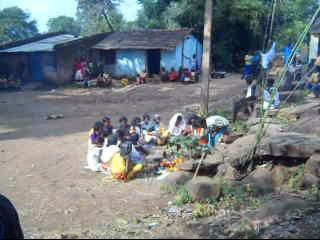 |
| Village communities are watching the ritual from a distance. |  |
| Village communities are moving towards the end of the village to give farewell to all the evil souls. |  |
| Sacrifice is a common practice by the tribal communities to satisfy the evil souls; different community members of the village are in queue to give their offer. | 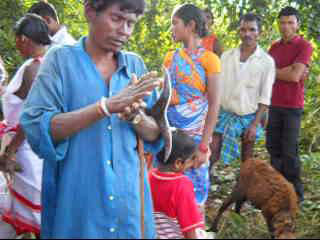 |
| Preparation before the sacrifice is made. |  |
| The buffalo was sacrificed to please the evil souls and the ancestors. They also sacrifice pigs, lamb and other animals. | 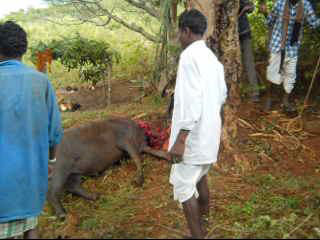 |
| Sacrifice is being done in the name of evil spirits and the ancestors of both the communities. | 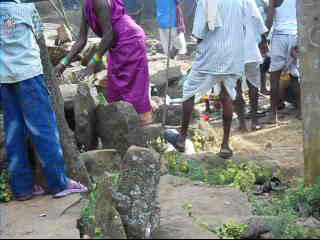 |
| Women participate actively as priests in many socio-religious functions. | 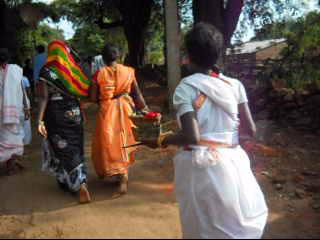 |
| Village forest, a place of congregation of different communities at the time of rituals |  |
Conclusion
Interdependence and interaction are the basic elements of every social system in the form of different social structures. It is also essential to carry forward the tradition along with necessary changes. In this context, the present study was carried out in Koraput District, which is known as the abode of the major tribal population in Odisha. Nevertheless, this is also the abode of scheduled caste population as well. The scheduled caste community is equally considered as the deprived community as per the socio-economic status and the corresponding constitutional provisions. However, from the anthropological point of view, the intercommunity interaction is very much existent and also vibrant in the socio-cultural and socio-economic life of the area. Though the interaction is in the form of exclusion and isolation, it is observed to be lively and integrative in nature. Different aspects of the continuing interaction are also studied.
The very purpose of the study has been to explore the base of the socio-cultural environment and the rationale of the interaction. This is to clarify the negativity of globalization and the changes that destroy the ethics or culture. Globalization, as a process or change, should help us to learn the essentials of living and then to build the future in a collaborative and constructive manner by learning from each other. It also advocates for crisis management and conflict resolution. Cultural integration featured in intercommunity interaction also answers some of the doubts regarding untouchability and the social hierarchy among the tribal and the non-tribal population.
The present study also reveals the tolerance at different levels, the perceptions of the other caste population, the cultural attributes amidst diverse cultures, which forge an integrating interaction that raise these indigenous people culturally for peaceful co-existence and sustenance.
References
- Blumer, Herbert,1969.Symbolic Interactionism: Perspective and Method. Englewood Cliffs, NJ: Prentice Hall.
- Dillion Michele, 2010.Introduction to Sociological Theory.West Sussex.Wiley-Blackwell.
- Goffman, Erving,1959. The Presentation of Self in Everyday Life. New York: Doubleday.
- Goffman, Erving,1979.Gender Advertisements.Cambridge, MA: Harvard University Press.
- Heath Hohwald, Manuel Cebri´an, Arturo Canales, Rub´en Lara, and Nuria Oliver, Inferring Unobservable Inter-community Links in Large Social Networks Telefonica Research, Madrid, Spain(Google search).
- Liben-Nowell and J. Kleinberg, 2003. The link prediction problem for social networks,” in CIKM ’03: Proceedings of the Twelfth International Conference on Information and Knowledge Management. New York, NY, USA: ACM Press, pp. 556–559. [Online]. Available: http://dx.doi.org/10.1145/956863.956972
- Mead George Herbert,1934.Mind,Self,and Society.Chicago:University ofChicago Press.
- Schubert,Hans-Albrech,1998.On Self and Social Organization.”Introduction”PP.1-31 in Charles HortonCooley.1902/1998Chicago:University of Chicago Press. Edited and with an introduction by Hans-Joachim Schubert.
- Sinha Dishit: Plurralism and cultural conflict in India (Google search.).
- Srinivas, M.N.,1992. On living in a revolution and other essays, New Delhi: Oxford.



